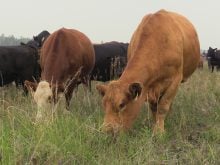This cattle market information is selected from the weekly report from Canfax, a division of the Canadian Cattlemen’s Association. More market information, analysis and statistics are available by becoming a Canfax subscriber by calling 403-275-5110 or at www.canfax.ca.
Historic high fed price
Alberta fed cattle prices rallied to historic highs last week with average steer prices $20 per hundredweight higher than pre-2023 highs set in 2015.
Sale volumes were light to moderate with dressed prices $5-$12 per cwt. higher than the previous week from $370-$375 per cwt. delivered. Weighted average steer prices closed the week $6 per cwt. higher than the previous week at $223.57.
Read Also

U.S. market can’t easily be replaced
The deputy chief economist of Farm Credit Canada says 92 per cent of Canada’s total exports to the U.S. went into the country duty-free in June.
Western Canadian fed slaughter for the four-day week ending April 8 was down 18 percent from the previous week to 35,078 head. Year-to-date western fed was slaughter was four percent lower than a year ago, totalling 574,323 head.
Fed cattle/cow exports to the United States for the week of April 1 were 21 percent larger than a year ago at 11,999 head. Year-to-date fed cattle/cow exports were down one percent from the same week last year, totalling 137,200 head.
Strong prices have pulled market-ready feedlot supplies forward and fed inventories are current. Yearling volumes continue to tighten, and feedlots are reluctant to pull soft fed calves forward.
In the U.S., light trade in the south saw live prices generally US$5 per cwt. higher than the previous week at $175 per cwt. Northern live sales were $6-$10 per cwt. higher than the previous week from $181-$185 per cwt. and dressed sales rallied $5-$12 per cwt. higher from $283-$290 per cwt. delivered. The bulk of dressed trade was reported $11 higher at $290 per cwt. delivered.
U.S. steer carcass weights for the week ending April 1 were three lb. larger than the previous week at 898 lb.
Total U.S. slaughter last week was estimated to be two percent larger than the previous week at 613,000 head and four percent smaller than a year ago. Stockers and feeders traded higher on cattle futures strength. Strong demand continued on a tighter supply of feeders.
Cow supplies dwindle
More calving culls are hitting the market, but cow supplies in general continue to be light across much of the Prairies. Alberta D2 cow prices have averaged on either side of $130 per cwt. in recent weeks. D2s averaged $130.42 and D3s averaged $115.92 per cwt. last week. Slaughter bulls averaged $152.44.
Demand from western Canadian packers and feeder cow buyers remains supportive. Western Canadian cow slaughter volumes were historically large during the first quarter of this year, but slaughter volumes recently dipped below year-ago levels. A lot of cows have already been worked through, so cow slaughter volumes will likely continue to moderate.
Tighter numbers are ahead because the Jan. 1 beef cow inventories in Alberta and Saskatchewan were down 4.8 percent and 1.8 percent, respectively, compared to last year. Culling rates will hopefully slow in the cow-calf sector because stronger calf prices are being projected this fall.
Feeder steers popular
Alberta 550 lb. feeder steer calves averaged more than $331 per cwt. last week, a new record high. This was the only class of cattle to set new highs last week. Same weight heifers traded about $10 per cwt. shy of their 2015 highs.
Since mid-March, 550 lb. heifer prices have risen $9 per cwt. The steer/heifer calf spread has narrowed considerably, going from $51-$57 per cwt. in early January to now around $36 per cwt. The steer/heifer calf price spread is the narrowest it has been all year. That spread is driven by feedlot performance differences and feed costs. As feedgrain prices drift lower, the spread will continue to narrow.
A few open replacement heifer sales were highlighted last week, but demand was lukewarm. Many breeding quality, palpated heifers were going to the feedlot or grass operators, where they probably won’t be exposed to a bull.
This week Alberta/Saskatchewan 900-1,000 lb. heifers for September delivery traded from $259-$265 per cwt., $4-$5 per cwt. higher compared to three weeks ago.
First quarter Canadian feeder cattle exports to the U.S. totalled 31,515 head, 61 percent lower than last year. Over the past 10 years, this stands as the second smallest first quarter feeder cattle export volume. Only 2021 was lower.
U.S. cutouts climb
In U.S. beef trade, cutouts continued their climb. Choice cutouts were up 3.7 percent, crossing the $300 per cwt. threshold to close at $300.42. Select cutouts were up 2.4 percent to $283.38 per cwt.














